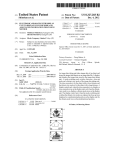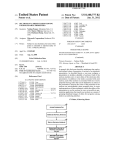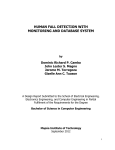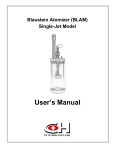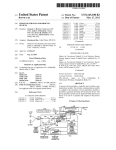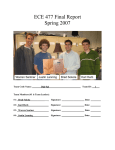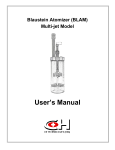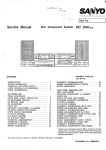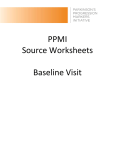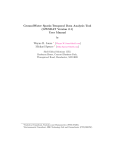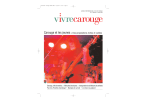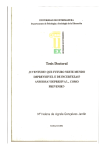Download Method and apparatus for performing try
Transcript
US008371896B2
(12) United States Patent
(10) Patent N0.:
(45) Date of Patent:
Baytman et a].
(54)
METHOD AND APPARATUS FOR
4,563,626
4,699,603
4,702,374
4,842,564
4,925,025
4,964,837
5,147,237
5,158,495
PERFORMING TRY-ME AND NORMAL PLAY
ROUTINES
(75) Inventors: Alexander L. Baytman, FairlaWn, NJ
(US); Konstantin Degtyarev, River
Edge, N] (U S)
5,172,806 A
5,173,071 A
(73) Assignee: Mattel, Inc., El Segundo, CA (US)
(*)
Notice:
5,188,222 A
Filed:
EP
EP
0928626
1221335 A2
7/1999
7/2002
OTHER PUBLICATIONS
Partial European Search Report issued Jun. 18, 2009, 4 pages.
Jul. 16,2009
(Continued)
Related US. Application Data
Provisional application No. 61/020,914, ?led on Jan.
14, 2008.
Int. Cl.
A63H 30/00
B65D 25/54
(52)
(58)
2/1993 Pierce
(Continued)
Prior Publication Data
US 2009/0181598 A1
(51)
12/1992 Mickelberg
12/1992 Hoeting
Jan. 9, 2009
(65)
(60)
5/1990
10/1990
9/1992
10/1992
Ohtake
Saigo et al.
Kelner
Gerold et al.
Anten et al.
Collier
Kwan et a1.
YoneZaWa
FOREIGN PATENT DOCUMENTS
USC 154(b) by 844 days.
(22)
1/1986
10/1987
10/1987
6/1989
Feb. 12, 2013
(Continued)
Subject to any disclaimer, the term of this
patent is extended or adjusted under 35
(21) Appl. No.: 12/351,384
A
A
A
A
A
A
A
A
US 8,371,896 B2
Primary Examiner * Dmitry Suhol
Assistant Examiner * Alex F. R. P. Rada, ll
(74) Attorney, Agent, or Firm * Panitch SchWarZe Belisario
& Nadel LLP
(57)
(2006.01)
(2006.01)
ABSTRACT
A toy includes electronics Which generates a plurality of
US. Cl. ....................... .. 446/175; 446/484; 206/775
Field of Classi?cation Search ................ .. 446/175,
446/484, 267; 206/775, 779*780, 457; 340/123,
340/ 12.31
routines and is con?gured to operate in a ?rst mode and in a
second mode, a ?rst sensor and a second sensor, each sensor
operably connected to the electronics. Actuation of the ?rst
sensor causes the electronics to generate a ?rst routine With
See application ?le for complete search history.
the electronics in the ?rst mode and to generate a second
References Cited
the second mode. Activation of the second sensor causes the
U.S. PATENT DOCUMENTS
electronics to generate of a third routine, different from the
?rst routine, and causes the electronics to be set to the second
mode. The electronics is set to the ?rst mode upon a ?rst
(56)
3,142,130 A
3,229,421 A
3,514,899 A
7/1964 Weitzell
1/1966 Ostrander
6/1970 Bonanno et al.
4,348,191 A
9/1982 LipsitZ etal.
routine, different from the ?rst routine, With the electronics in
application of electrical poWer to the electronics.
17 Claims, 3 Drawing Sheets
US 8,371,896 B2
Page2
U.S. PATENT DOCUMENTS
5,283,567 A
5,289,916 A
“994 HQWGS
3/1994 Mwkelberg
6,896,573 B1*
5/2005 Rogers ............................ .. 446/8
6,909,374 B2
6,948,999 B2*
7,088,259 B2
6/2005 Fon
9/2005 (311351 ........................... .. 446/219
8/2006 Armbruster et al.
213%? A
$33: gatkiyatn?
7,094,981 B2
5334076 A
8/1994 51111110511133‘
7’120’257 B2
5’4l0’326 A
5,411,138 A
4/l995 Goldstein
M995 Klawiter
7,356,952 B2
7,422,506 B2
’
’
7,448,969 B2
2,325,338 A
3;}??? (L30? H d
7,578,393 B2*
8/2006 Sorrentino et al.
10/2006 Mahoney
4/2008 Sweeneyetal.
9/2008 Lundetal.
11/2008
Weberetal.
8/2009 Gillon ......................... .. 206/774
5465909 A
“H995 Rg?‘fnse
7,641,052 B2*
5525972 A
M996 Inokoshi
2001/0034181A1*
31333 3333333313 3331.
gggg/gggggg 3}
33335 53;; .
2003/0114075
6/2003
3,333,333 A
5607 338 A
3/1997 Landi
5,622,258 A
‘$1997 Baull’llltz 6‘ a1~
’
’
.
2125212} A * 2A3; éfllgezfe
5,691,578 A *
’
’
“998
A
5741185 A
’
“H997 Driska
Ch
5,858,262 A
2004/0087241 A1*
206M591
~~~~~~~~~~~~~~~~~ "
307m~2
"""""""""""" "
31998 B elcllr
2005/0284788 A1
pp‘
Molletal.
.................. .. 446/456
5/2004 Agostini et a1. .............. .. 446/36
12/2005 Elliott et a1.
2006/0014472 A1*
1/2006
Spielberger ................. .. 446/477
2006/0207901 A1
9/2006
S0rrent1n0etal.
2007/0031808 A1
'
8/1998 Moore
V1999 Lebensff?d
2/2007 Wei
2007/0042614 A1
2/2007
2007/0082764 A1
4/2007 Weber etal.
Marmaropoulos et a1.
2007/0138923 A1
6/2007 Sokola
5,905,429 A
5,984,788 A
5/1999 H0rnste1n et a1.
11/1999 Lebensfeldet a1.
2007/0l84722 Al
Zoos/0129530 A1
8/2007 Doherty
600% Lokos
2%??? A
ligggg
2008/0202003 A1
8/2008 Sweeney et al.
63021941 A
6,028,533 A
6,071,166 A
2/2000 Schultz
2/2000 Javors
6/2000 Lebensfeld etal.
6,139,087 A
6,311,837 B1
10/2000 Wolfmaier et a1.
11/2001 Blaustein et a1.
6,319,087 B1*
11/2001
Ferrigno
206/779
Bakst .......................... .. 446/242
2006/0270312 A1* 11/2006 Maddocks et a1. .......... .. 446/337
M998
’
5,795,209 A
A1*
1/2010 Ca1endri11e,Jr.
10/2001
FOREIGN PATENT DOCUMENTS
W0
W0
WO-99/03549
1/1999
WO-99/35627
7/1999
OTHER PUBLICATIONS
..................... .. 446/297
_
_
_
6,377,187 B1
4/2002 Pong
EP-Supplementa1SearchRep01t1ssued0nJun. 16,20101nEPApp11
6,437,703 B1
6,520,828 132*
g/ZOOZ pong
2/2003 perrigno ,,,,,,,,,,,,,,,,,,,,, H 446/330
cat10n N0.09000454.0-2318.
I
I
Of?ce Act10n Issued Oct. 14, 2010 1n Ch1nese Appln. No.
6,705,919 B2
3/2004 Curran et a1.
2009101267610
6,727,826 131*
4/2004 KiKWan etal, ,,,,,,,,,,, H 340/123
Of?ce Action issued Oct. 9, 2011 in CN Application No.
2009101267610.
6,749,437 B2
6/2004 Chan
6,758,716 B1 *
7/2004 Rehkemper et a1. ........ .. 446/297
6,889,829 B2
5/2005 Lev et a1.
* cited by examiner
US. Patent
Feb. 12, 2013
Sheet 1 of3
US 8,371,896 B2
US. Patent
Feb. 12, 2013
Sheet 3 0f 3
US 8,371,896 B2
101
1
POWER RESET
1’ '
V
Set try-me mode
l,
v
Stand By — try-me mode
103
/\/
105
{J
111
,\/
Play try-me routine
Set normal mode
V
Play normal routine
V
7
Stand By — normal mode
117
Try-me or normal
pla sensor
ac uated?
US 8,371,896 B2
1
2
A second aspect of the invention in its broadest form is a
METHOD AND APPARATUS FOR
PERFORMING TRY-ME AND NORMAL PLAY
ROUTINES
method of operating a toy having electronics con?gured to
operate in a ?rst mode and a second mode, a ?rst sensor
operably connected to the electronics and a second sensor
operably connected to the electronics, the method comprising
CROSS-REFERENCE TO RELATED
APPLICATIONS
the steps of: setting the electronics to be in the ?rst mode upon
a ?rst application of electrical poWer to the electronics; user
actuating the ?rst sensor to cause the electronics to generate a
?rst routine With the electronics in the ?rst mode and to
generate a second routine different from the ?rst routine With
This application claims the bene?t of provisional applica
tionNo. 61/020,914, ?led Jan. 14, 2008, the contents ofWhich
are incorporated by reference in the entirety.
the electronics in the second mode; and user actuating the
BACKGROUND OF THE INVENTION
second sensor to cause the electronics to generate a third
routine different from the ?rst routine and the second routine
Try-me is generally knoWn as an operating mode of a toy
and to cause the electronics to be set to the second mode.
Which in it’ s normal mode provides one or more normal play
routines and Which provides in the try-me mode one or more
A third aspect of the invention is a packaged toy compris
ing: a toy including a plurality of user actuated sWitches, a
abbreviated play routines compared to the toy’s normal play
computer chip controller in the toy operatively connected
routines. Typically, a toy having a try-me mode is set by the
manufacturer to operate in the try-me mode While the toy is in
a package on a store shelf. By providing a toy With a try-me
With each of the plurality of user actuated sWitches, and a
20
mode, the user is able gain some idea of the toy’s capabilities
While the toy is still in the package on the store shelf. Try-me
in a different Way, the plurality of preprogrammed routines
is especially useful for battery operated toys having a normal
play routines of complicated scripts, long performance pat
terns, motor operation, displays, sounds and/or lights Which
plurality of preprogrammed routines stored in the toy, each
routine directing controller activation and operation of the toy
25
including at least a ?rst set of one or more try-me routines;
and a second set of tWo or more normal routines, and each of
the plurality of sWitches being associated With one or more
consume a relatively large amount of battery energy.
Generally, sWitching betWeen the try-me mode and a mode
particular routines of the plurality. It further comprises a
package containing the toy and con?gured to expose one or
in Which normal play routines are performed (i.e. normal
mode) is done by detecting the state of a try-me sWitch by a
computer chip controlling the modes and routines of the toy.
Such a try-me sWitch is generally distinct from the sWitches
Which are used by the user for selecting a particular play
routine.
In the prior art, the user is required to take some positive
action distinct from selecting a play routine to sWitch the toy
from the try-me mode to the normal mode. One knoWn
method of sWitching betWeen try-me mode and the normal
mode uses a removable tab Which, While in place in the toy,
more of the plurality of sWitches to permit user actuation of
the at least the one or more exposed sWitches With the toy in
actuates the try-me sWitch to put the toy into a try-me state.
The tab, often a thin piece of plastic, sometimes With an
30
the package and to cover one or more remaining sWitches of
the plurality of sWitches to prevent user actuation of the one or
more remaining sWitches With the toy in the package before
35
the package is opened. The controller is con?gured to (1)
initially execute only preprogrammed try-me routines of the
?rst set in response to activations of the one or more sWitches
of the plurality exposed to user actuation With the toy in the
package, (2) execute one of the preprogrammed normal rou
tines of the second set in direct response to user activation of
40
any of the remaining sWitches, and (3) thereafter execute
appropriate message (for example, “Discard by adult, pull out
preprogrammed normal routines from the second set in
for normal play mode”) is removed either automatically When
response to actuation of any of the one or more sWitches
the toy is removed from the package or manually by the user
after the toy is removed from the package to enable the normal
exposed to the user With the toy in the package, at least one of
the preprogrammed normal routines executable by the con
play mode.
45
It Would be desirable to have a method of sWitching
troller after (2) in response to activation of any of the one or
betWeen try-me mode and normal mode of operation that
more sWitches exposed With the toy in the package being
different from each of the preprogrammed try-me routines of
does not require an additional component such as a separate
the ?rst set, Whereby the toy automatically recon?gures itself
sWitch for affecting the sWitching betWeen try-me mode and
normal mode, or does not require the user to take a speci?c
from a try-me mode of operation to a normal play mode of
50
action distinct from selecting a play routine, such as removing
the tab.
BRIEF DESCRIPTION OF THE SEVERAL
VIEWS OF THE DRAWINGS
SUMMARY OF THE INVENTION
55
A ?rst aspect of the invention in its broadest form is a toy
comprising: electronics con?gured to generate a plurality of
routines and to operate in a ?rst mode and in a second mode;
a ?rst sensor operably connected to the electronics, user
actuation of Which causes the electronics to generate a ?rst
routine With the electronics is in the ?rst mode and to generate
a second routine, different from the ?rst routine With the
electronics in the second mode; and a second sensor operably
connected to the electronics, user actuation of Which causes
the electronics to generate of a third routine, different from
the ?rst routine and the second routine, and causes the elec
tronics to be set to the second mode.
operation.
60
65
The foregoing summary, as Well as the folloWing detailed
description of the invention, Will be better understood When
read in conjunction With the appended draWings. For the
purpose of illustrating the invention, there are shoWn in the
draWings embodiments Which are presently preferred. It
should be understood, hoWever, that the invention is not lim
ited to the precise arrangements and instrumentalities shoWn.
In the draWings:
FIG. 1 is a plan vieW of a preferred embodiment of package
in combination With a toy having a try-me mode;
FIG. 2 is a schematic circuit diagram of electronics for
implementing the preferred embodiment, and
US 8,371,896 B2
3
4
FIG. 3 is a ?owchart of a preferred method for switching
between try-me and normal modes.
play” routines). Try-me routines are generally abbreviated in
some manner compared the normal routines in order to con
serve battery life. A try-me routine lets the user exercise one
or more of the devices that can be exercised With the toy 10 in
DETAILED DESCRIPTION OF THE INVENTION
the package 12 to give the user a glimpse of the operating
capabilities of the toy 10 Without draining the batteries before
the toy 10 is removed from the package 12.
While only a single try-me routine and tWo normal routines
are required by the invention, the only limit to the number of
try-me routines and normal routines that the toy 10 has is the
capacity of the toy 10 and electronics 25 to store instructions.
Referring noW to FIG. 1 there is shoWn the combination of
a toy 10 contained in a package 12. The toy 10 is initially
inserted into the package 12 With a source of poWer such as
one or more batteries (LR44 in FIG. 2). The toy 10 includes a
plurality of sensors at various locations on or in the toy 12 that
are user activated to cause the toy to operate in predetermined
Ways. In the depicted embodiment, the package 12 has a
cutout 18 through Which a portion of the enclosed toy 10 is
Typically, a ?rst set of a limited number of try-me routines
and a second set of normal routines much greater in number
than the number of try-me routines, are stored prepro
visible and accessible to a user. The toy 10 and package 12 are
con?gured to expose at least a ?rst sensor 14 for user access
and activation With the toy 10 in the package 12 and to cover
grammed in the toy 10 and electronics 25 for enhanced and
or otherWise to prevent user access and actuation of at least a
more varied operation of the toy in normal use.
There may even be a correspondence betWeen routines
With a try-me routine being a normal routine truncated to be
second sensor 16 With the toy 10 in the package 12.
There is no limit to the number of user activated sensors
that may be included With the toy 1 0. Yet a third sensor 17 may
20
be provided With the second sensor 16 to be covered by the
package 12 While a fourth sensor 15 can be provided exposed
With the toy 1 0 in the package 12 for user manual activation of
the toy 10 in the package 12. Sensors used in the present
invention are devices that respond to a user initiated physical
toy) or both shorter duration and feWer activations than a
25
a resulting greater poWer drain than all or at least nearly all of
electrical signal. In the preferred embodiment of the present
subsequently referred to as switches.
Referring to FIG. 2, the toy 10 also includes electronics
indicated generally at 25. Each of the sensors 14-17 is oper
ably connected to the electronics 25. The toy 10 also includes
at least one and preferably a plurality of electrically operated
particular normal routine. Conversely, normal routines are
more extensive, i.e. longer in duration and/or have a greater
number of attributes or activations such as greater variety of
sounds, mechanical operation and/ or light operation(s), With
stimulus such as heat, light, sound, pressure, magnetism or a
particular motion and transmit a resulting impulse or other
invention, each of the sensors 14-17 is preferably a sWitch on
or in the toy 10, Which is manually actuated to make or break
the How of electrical current. Sensors 14-17 may also be
shorter in duration or having feWer attributes (feWer activa
tions of sound, light, movement and/or other activity of the
the provided try-me routines exercising the same devices.
The toy 10 is con?gured through con?guration of the elec
30
tronics 25 to operate in tWo different modes, a ?rst or “try
me” mode and a second or “normal” or “normal play” mode.
Only the try-me routines are performed While the toy 10 and
the electronics 25 are in the ?rst or try-me mode. Normal
routines are performed only While the toy 10 and electronics
35
25 are in the second or normal mode. This distinction is
important. Normal routines cannot be performed by the toy in
or electronically responsive devices such as one or more
the try-me mode of operation but the toy and electronics can
sound generators like speaker 40, one or more light genera
be con?gured to continue to perform one or more try-me
routines in the normal mode of operation.
tors like LED 50 or even like a display screen 52, and/or one
or more electrically controlled prime movers like motor 60 or 40
According to the invention, the toy 10 and electronics 25
are con?gured to change from the try-me to the normal mode
of operation by user actuation of one of the normal routine
activating sensors. Toy 10 and package 12 are con?gured to
solenoids, pumps, etc. to make the toy responsive to the user.
Each device 40, 50, 52, 60 is operably connected With the
electronics 25 to be controlled (activated and operated) by the
electronics 25. The electrically controlled devices are not
limited to those enumerated above.
The toy 10 is made to respond in a variety of different Ways
expose sensors 14 and 15 to user access With the toy 10
45
contained in the package 12. Sensors 14, 15 constitute a ?rst
or “try-me” subset of the sensors. Toy 10 and package 12 are
through the various provided devices 540, 50, 52, 60, etc., to
further con?gured to cover or otherWise prevent user access to
user activation of the sensors 14-17. Each different Way is
referred to as a routine. Reference to “routine” hereinafter in
sensors 16, 17 With the toy 10 contained in the package 12.
describing the present invention denotes a ?nite duration
Sensors 16, 17 constitute a second or “normal” or “normal
50
package 12, either by normal opening or by destruction of the
activity of the toy 10, Which may include generation of sound,
light, heat, magnetic, electrostatic or electro-magnetic
package 12 around the toy, at least the second sensor 16
and/or the third sensor 17 of the second subset of sensors,
mechanical activity or any combination of the above, under
the control of the electronics 25. The electronics 25 are con
?gured to “generate” the routines in that the electronics
include sets of predetermined instructions that direct the elec
tronics 25 (and computer chip 20 in particular) to activate and
operate the toy 10 by control of the operation of the various
devices 40, 50, 52, 60, etc. in accordance With those instruc
tions. Each routine typically requires a separate set of prede
become user accessible.
55
60
termined instructions to be stored in the electronics 25 and
“routine” should also be understoodto refer to a set of instruc
tions as Well as the physical activities.
According to the invention, the toy 10 and the electronics
25 are provided With at least a ?rst routine (hereafter also
referred to as a “try-me” routine), and at least second and third
routines (hereafter also referred to as “normal” or “normal
play” subset of the sensors. With the toy 10 removed from the
65
Further according to the invention, user activation of a ?rst
sensor (like sensor 14) operably connected to the electronics
25 con?gured in the ?rst or try-me mode causes the electron
ics 25 to generate at least a ?rst routine, a try-me routine, and
With the electronics 25 in the second mode, to generate at least
a second routine, a normal routine, Which is different from the
?rst routine. Further according to the invention, user activa
tion of a second sensor (like sensor 16) operably connected to
the electronics 25 and different from the ?rst sensor causes
the electronics 25 to generate a third routine different from the
?rst routine, and also causes the electronics 25 to set itself to
the second or normal mode. These are minimum require
ments of the invention.
US 8,371,896 B2
5
6
More preferably, the electronics 25 are con?gured to gen
erate any of a ?rst subset of the stored try-me routines in
has been actuated. If a try-me sWitch 14, 15 is actuated, a
try-me routine is performed (step 111) and thereafter, the toy
response to user activation of the ?rst sensor 14 With the
10 returns to the try-me mode (step 105). If no sWitch 14-17
electronics 25 in the ?rst or try-me mode. The electronics 25
are further con?gured to generate any of a second subset of
the stored normal routines, Where the normal routines are
different from each try-me routine that is provided, but can be
generated only With the electronics 25 in the second or normal
is actuated, the toy 10 stays in the try-me mode (step 105).
In the preferred embodiment, if a normal routine sWitch 16
or 17 is actuated While the toy 1 0 is in the try-me mode, the toy
10 automatically sWitches to the normal mode (step 109) and
performs a normal routine corresponding to the sWitch 16, 17
that Was actuated (step 113). FolloWing the performance of
the selected normal routine (step 113), the toy 10 remains in
the normal mode (step 115) until reset (step 101). In the
normal mode, the computer chip U1 periodically queries the
mode. The same is true of user activation of the fourth sensor
15 although the electronics 25 Will typically store separate
subsets of try-me and normal routines different from the
routines and subsets stored for response to the ?rst sensor 14.
The electronics 25 are similarly con?gured to respond to the
state of each play routine sWitch 14-17 to determine if any one
?rst user actuation of either the second 16 or the third sensor
17 to generate a normal routine from a separate subset of
stored normal routines and to set itself to the second or normal
of the sWitches 14-17 has been activated (step 117). If any
mode of operation. In this Way, each of the sensors 14-17 is
typically associatedWith one or more particular routines of all
those routines stored in the toy 10.
actuated, the toy 10 stays in the normal mode (step 115).
Referring to FIG. 2, preferably, the electronics 25 includes
sWitch 14-17 is actuated, a normal routine associated With the
activated sWitch is performed (step 113). If no sWitch 14-17 is
If the toy 10 is con?gured for a one time try-me con?gu
ration, the electronics 25 Will be con?gured to automatically
20
advance to step 115 each time poWer is interrupted and reap
a controller indicated diagrammatically as a computer chip
U1 to receive signals from the sWitches 14-17 and to store and
plied.
execute the commands constituting the routines, Which pro
duce the activities associated With routines. Computer chip
could be made to the embodiments described above Without
U1 is conventional and includes all necessary memory and
processing capability as Well as any other capability needed to
It Will be appreciated by those skilled in the art that changes
25
activate, operate, control the various provided devices 40, 50,
52, 60, etc. HoWever, it is not necessary that a computer chip
be used in the electronic portion 25. The electronics 25 may
be a comprised of discrete components such as resistors,
30
1. A packaged toy comprising:
a toy including:
electronics con?gured to generate a plurality of routines
capacitors and transistors mounted on one or more substrates.
Alternatively, a combination of individual computer chips
and/ or discrete computer components may be used.
Preferably, the electronics 25 are set or con?gured to be in
or to enter the ?rst or (try-me) mode of operation upon a ?rst
departing from the broad inventive concept thereof. It is
understood, therefore, that this invention is not limited to the
particular embodiments disclosed, but it is intended to cover
modi?cations Within the spirit and scope of the present inven
tion as de?ned by the appended claims.
We claim:
35
and to operate in a ?rst mode and in a second mode;
a ?rst sensor operably connected to the electronics, user
actuation of Which causes the electronics to generate a
?rst routine With the electronics in the ?rst mode and to
generate a second routine, different from the ?rst rou
application of electrical poWer to the electronics 25. This
means the electronics 25 may be con?gured to be set to the
?rst mode each time the electrical poWer to the electronics 25
is interrupted and reapplied to the electronics 25, or the elec
tronics 25 may be con?gured to be set to the ?rst mode only
the ?rst time electrical poWer is applied to the electronics 25
and never again thereafter regardless of Whether poWer is
tine, With the electronics in the second mode; and
40
a second sensor operably connected to the electronics, user
actuation of Which causes the electronics to generate a
third routine, different from the ?rst routine, and causes
the electronics to be set to the second mode; and
subsequently interrupted and reapplied.
a package containing the toy, the toy and the package being
The toy 10 may include a mechanical on-off sWitch 20 for
controlling the application of the battery poWer to the toy 10.
If provided, the on-off sWitch 20 is set to the “on” position
When the toy 10 is inserted into the package 12 by the manu
facturer and is preferably concealed from a user While the toy
10 is enclosed in the package 12. Preferably, the ?rst appli
cation of electrical poWer occurs by operation of the on-off
sWitch 20 from the “off” position to the “on” position after
installation of the batteries or installation of the batteries by
the manufacturer While the sWitch 20 is in the “on” position.
FIG. 3 depicts operation of a preferred embodiment toy 10.
50
With a source of poWer such as batteries installed in the toy
55
user actuation of the second sensor With the toy con
tained in the package, the electronics being in the ?rst
mode in the package;
computer chip U1 enters the try-me mode (step 103). Gener
ally, the toy 1 0 is pre-programmed to be in the try-me mode by
the manufacturer and is in the try-me mode When placed in the
package 12 by the manufacturer.
While in the try-me mode, the computer chip controller U1
periodically queries the state of each play routine sWitch
14-17 (step 107) to determine if any one of the sWitches 14-17
Wherein the electronics is reset to the ?rst mode each time
electrical poWer to the electronics is interrupted and
reapplied to the electronics.
2. The packaged toy of claim 1, Wherein the second routine
is more extensive than the ?rst routine.
3. The packaged toy of claim 1, Wherein the second sensor
10, the try-me mode is entered the ?rst time the poWer to the
toy 10 is turned from off to on by actuation of the on-off
sWitch 20 With the batteries installed, or by batteries LR44
being added or replaced While the sWitch 20 is in the “on”
position (step 101). Upon sensing the change in poWer, the
con?gured to expose the ?rst sensor for actuation by a
user With the toy contained in the package and to prevent
45
is covered by the package With the toy contained in the pack
age.
4. The toy of claim 1 Wherein:
the ?rst mode is a try-me mode and the ?rst routine is a
try-me routine; and
60
the second mode is a normal mode and the second and third
routines are normal routines, the normal routines only
being generated by the electronics With the electronics in
the second, normal mode.
5. A packaged toy comprising:
65
a toy including:
electronics con?gured to generate a plurality of routines
and to operate in a ?rst mode and in a second mode;
US 8,371,896 B2
8
7
routine in the package and at least the second sensor
being covered in the package to prevent user actuation of
the second sensor With the toy in the package;
a ?rst sensor operably connected to the electronics, user
actuation of Which causes the electronics to generate a
?rst routine With the electronics in the ?rst mode and to
generate a second routine, different from the ?rst rou
removing the toy from the package suf?ciently to expose at
tine, With the electronics in the second mode; and
least the second sensor for user actuation;
user actuating the second sensor to cause the electronics to
a second sensor operably connected to the electronics, user
actuation of Which causes the electronics to generate a
generate a third routine different from the ?rst routine
and to cause the electronics to be set to the second mode;
third routine, different from the ?rst routine, and causes
the electronics to be set to the second mode; and
and
a package containing the toy, the toy and the package being
further including the step of resetting the electronics to the
con?gured to expose the ?rst sensor for actuation by a
user With the toy contained in the package and to prevent
?rst mode each time electrical poWer to the electronics is
interrupted and reapplied to the electronics.
11. A method of operating a toy initially in a package, the
toy having electronics con?gured to operate in a ?rst mode
user actuation of the second sensor With the toy con
tained in the package, the electronics being in the ?rst
mode in the package;
and a second mode, a ?rst sensor operably connected to the
electronics and a second sensor operably connected to the
Wherein the electronics is set to the ?rst mode only a ?rst
time electrical poWer is applied to the electronics.
electronics, the toy in the package being internally powered
With the electronics con?gured in the ?rst mode, the method
6. The packaged toy of claim 5, Wherein the second sensor
comprising the steps of:
is covered by the package With the toy contained in the pack
age.
20
7. The toy of claim 5 Wherein:
the ?rst mode is a try-me mode and the ?rst routine is a
try-me routine; and
the second mode is a normal mode and the second and third
routines are normal routines, the normal routines only
25
being generated by the electronics With the electronics in
the second, normal mode.
generate a ?rst routine With the electronics in the ?rst
mode and to generate a second routine different from the
?rst routine With the electronics in the second mode, at
least the ?rst sensor being exposed on the toy in the
package for user actuation of the toy to generate the ?rst
routine in the package and at least the second sensor
being covered in the package to prevent user actuation of
the second sensor With the toy in the package;
removing the toy from the package suf?ciently to expose at
8. A method of operating a toy initially in a package, the toy
having electronics con?gured to operate in a ?rst mode and a
second mode, a ?rst sensor operably connected to the elec
tronics and a second sensor operably connected to the elec
user actuating the ?rst sensor to cause the electronics to
30
least the second sensor for user actuation;
user actuating the second sensor to cause the electronics to
tronics, the toy in the package being internally powered With
generate a third routine different from the ?rst routine
the electronics con?gured in the ?rst mode, the method com
and to cause the electronics to be set to the second mode;
prising the steps of:
and
user actuating the ?rst sensor to cause the electronics to 35
generate a ?rst routine With the electronics in the ?rst
mode and to generate a second routine different from the
?rst routine With the electronics in the second mode, at
least the ?rst sensor being exposed on the toy in the
package for user actuation of the toy to generate the ?rst
routine in the package and at least the second sensor
further including the step of retaining the electronics in the
second mode each time electrical poWer to the electron
ics is interrupted and reapplied to the electronics after
the user actuating the second sensor step.
12. A packaged toy comprising:
40
a toy including a plurality of user actuated sWitches, a
computer chip controller in the toy operatively con
being covered in the package to prevent user actuation of
the second sensor With the toy in the package;
removing the toy from the package suf?ciently to expose at
nected With each of the plurality of user actuated
45
least the second sensor for user actuation;
user actuating the second sensor to cause the electronics to
vation and operation of the toy in a different Way, the
plurality of preprogrammed routines including at least a
generate a third routine different from the ?rst routine
and to cause the electronics to be set to the second mode;
?rst set of one or more try-me routines and a second set
sWitches, and a plurality of preprogrammed routines
stored in the toy, each routine directing controller acti
of tWo or more normal routines, and each of the plurality
of sWitches being associated With one or more particular
and
after the second actuating step, the step of resetting the
50
10. A method of operating a toy initially in a package, the
toy having electronics con?gured to operate in a ?rst mode
or more of the plurality of sWitches to permit user actua
tion of the at least the one or more exposed sWitches With
the toy in the package and to cover at least one or more
55
remaining sWitches of the plurality of sWitches to pre
vent user actuation of the one or more remaining
sWitches With the toy in the package before the package
and a second mode, a ?rst sensor operably connected to the
electronics and a second sensor operably connected to the
electronics, the toy in the package being internally powered
With the electronics con?gured in the ?rst mode, the method
routines of the plurality;
a package containing the toy and con?gured to expose one
electronics to the ?rst mode upon a reapplication of
electrical poWer to the electronics.
9. The method of claim 8, Wherein the second routine is
more extensive than the ?rst routine.
60
comprising the steps of:
is opened;
Wherein the computer chip controller is con?gured to (I)
initially execute only preprogrammed try-me routines of
the ?rst set in response to activations of the one or more
user actuating the ?rst sensor to cause the electronics to
sWitches of the plurality exposed to user actuation With
generate a ?rst routine With the electronics in the ?rst
mode and to generate a second routine different from the
?rst routine With the electronics in the second mode, at
least the ?rst sensor being exposed on the toy in the
package for user actuation of the toy to generate the ?rst
the toy in the package, (2) self-set automatically into the
second mode of operation in direct response to a ?rst
65
activation of any of the remaining sWitches of the plu
rality originally covered by the package and execute one
of the preprogrammed normal routines of the second set
US 8,371,896 B2
10
in direct response to user activation of any of the remain
mode; a ?rst sensor operably connected to the electronics,
ing switches, both Without furtheruser input into the toy,
user actuation of Which causes the electronics to generate a
and (3) thereafter execute preprogrammed normal rou
?rst routine With the electronics in the ?rst mode and to
generate a second routine, different from the ?rst routine,
tines from the second set in response to actuation of any
With the electronics in the second mode; and a second sensor
operably connected to the electronics, user actuation of Which
causes the electronics to generate a third routine, different
from the ?rst routine, and causes the electronics to be set to
of the one or more sWitches exposed to user actuation
With the toy in the package, at least one of the prepro
grammed normal routines executable by the controller
after (2) in response to activation of any of the one or
the second mode; the method comprising the steps of;
more sWitches initially exposed With the toy in the pack
age being different from each of the preprogrammed
try-me routines of the ?rst set, Whereby the toy automati
cally recon?gures itself from a try-me mode of operation
con?guring the electronics to be in the ?rst mode of opera
tion upon a ?rst application of poWer to the electronics;
con?guring the electronics to thereafter respond to a
manual actuation of the ?rst sensor With the electronics
in the ?rst mode and the ?rst application of poWer still on
to a normal play mode of operation.
13. The toy of claim 12 Wherein the computer chip con
troller is electrically connected With each of the plurality of
the electronics by generating a ?rst routine operating the
toy;
user actuated sWitches, Wherein the toy further includes one
con?guring the electronics to thereafter respond to a ?rst
manual actuation of the second sensor With the electron
ics in the ?rst mode and the ?rst application of poWer
or more electrically operated or electronically responsive
devices other than the plurality of manually actuated sWitches
also electrically connected to the computer chip controller for
control of the device by the computer chip controller to per
form all of the try-me routines of the ?rst set and all of the
still on the electronics by automatically self-setting into
the second mode of operation and generating a third
routine operating the toy differently from the ?rst rou
tine Without further user input; and
con?guring the electronics to thereafter respond to a
normal routines of the second set.
14. A method of operating a toy originally provided in a
package Wherein the toy includes electronics con?gured to
generate a plurality of routines and to operate in a ?rst mode
and in a second mode, a ?rst sensor operably connected to the
25
in the second mode and the ?rst application of poWer still
on the electronics by generating a second routine oper
electronics, user actuation of Which causes the electronics to
ating the toy differently from the ?rst routine and the
third routine, the electronics being con?gured to gener
generate a ?rst routine With the electronics in the ?rst mode
and to generate a second routine different from the ?rst rou
tine With the electronics in the second mode, and a second
sensor operably connected to the electronics, user actuation
ate the second routine only With the electronics in a
mode of operation other than the ?rst mode.
16. The toy con?gured by the method of claim 15.
17. A toy in a package, the toy comprising:
of Which causes the electronics to generate a third routine
different from the ?rst routine and causes the electronics to be
set to the second mode; Wherein the package containing the
toy is con?gured to expose the ?rst sensor for actuation by a
user With the toy contained in the package and to prevent user
actuation of the second sensor With the toy contained in the
35
electronics, the method comprising the steps of:
removing the toy from the package suf?ciently to expose
operably connected to the electronics; and
the package receiving the toy and being con?gured to
40
the electronics to set the electronics into the second
mode of operation and to generate a third routine oper
the toy and the electronics being in the ?rst, try-me mode
in the package;
45
ating the toy differently from the ?rst routine, both With
out any further required user input; and
manually actuating the ?rst sensor With the electronics in
the second mode and the ?rst application of poWer still
?rst, try-me routine; and
Wherein the toy and the electronics are further con?gured
the toy differently from any ?rst routine and from the
third routine, the electronics being con?gured to gener
ate the second routine only With the electronics in a
rality of routines and to operate in a ?rst mode and in a second
Wherein the toy and the electronics are con?gured such that
user activation of the ?rst sensor With the toy in the ?rst,
try-me mode in the package causes the electronics to
generate at least a ?rst, try-me routine and With the toy
and the electronics in the second, normal mode, to gen
erate at least a second, normal routine different from the
on the electronics to generate a second routine operating
mode of operation other than the ?rst mode.
15. A method of con?guring a toy for operation by a user,
the toy comprising electronics con?gured to generate a plu
expose at least the ?rst sensor for actuation by a user
With the toy in the package and to prevent user actuation
of at least the second sensor With the toy in the package,
the second sensor for actuation;
manually actuating the second sensor With the electronics
in the ?rst mode and the ?rst application of poWer still on
electronics con?gured to generate a plurality of routines
and to operate in any of at least a ?rst, try-me mode and
a second, normal mode; and
at least a ?rst sensor and a second sensor, each sensor being
package; and Wherein the toy is provided in the package With
the electronic in the ?rst mode and poWer supplied to the
manual actuation of the ?rst sensor With the electronics
such that a ?rst user activation of the second sensor
causes the electronics to generate a third, normal routine
55
different from the ?rst, try-me routine, and also causes
the electronics to automatically self-set to the second,
normal mode Without additional user input.
*
*
*
*
*










